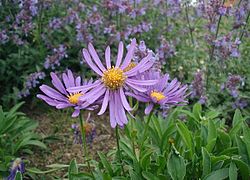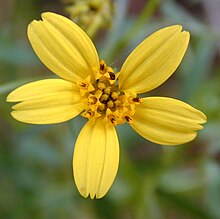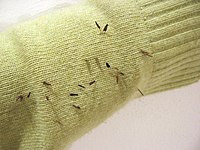Asteraceae: Difference between revisions
m robot Adding: is:Körfublómaætt |
m Bot: Converting incorrect references (read explanations |
||
| Line 73: | Line 73: | ||
=== Fruits and seeds === |
=== Fruits and seeds === |
||
[[Image:Kih-silberdistel.jpg|thumb|250px|right|Seeds are dispersed by the wind in ''[[Carlina]]'']] |
[[Image:Kih-silberdistel.jpg|thumb|250px|right|Seeds are dispersed by the wind in ''[[Carlina]]'']] |
||
The fruit of the Asteraceae is a specialised type of [[achene]], sometimes called ''cypsela'' (plural ''cypselae''). One [[seed]] per fruit is formed. It may sometimes be flat, winged or spiny and it adheres to the persistent pappus. Its [[morphology (biology)|morphology]] is often used to help determine plant relationships at the genus and species level<ref>http://apt.allenpress.com/aptonline/?request=get-abstract&issn=0026-6493&volume=092&issue=04&page=0569</ref>. The [[seed]]s usually have little or lack [[endosperm]] <ref name="Judd"/>. |
The fruit of the Asteraceae is a specialised type of [[achene]], sometimes called ''cypsela'' (plural ''cypselae''). One [[seed]] per fruit is formed. It may sometimes be flat, winged or spiny and it adheres to the persistent pappus. Its [[morphology (biology)|morphology]] is often used to help determine plant relationships at the genus and species level<ref>[http://apt.allenpress.com/aptonline/?request=get-abstract&issn=0026-6493&volume=092&issue=04&page=0569 APT Online - MORPHOLOGY OF CYPSELAE IN SUBTRIBE ARCTOTIDINAE (COMPOSITAE–ARCTOTIDEAE) AND ITS TAXONOMIC IMPLICATIONS<!-- Bot generated title -->]</ref>. The [[seed]]s usually have little or lack [[endosperm]] <ref name="Judd"/>. |
||
=== Metabolites === |
=== Metabolites === |
||
Revision as of 10:47, 11 January 2008
| Asteraceae | |
|---|---|

| |
| Aster alpinus | |
| Scientific classification | |
| Kingdom: | |
| Division: | |
| Class: | |
| Order: | |
| Family: | Asteraceae Martynov, 1820
|
| Type genus | |
| Aster | |
| Synonyms | |
|
Compositae Giseke | |
The family Asteraceae or Compositae, known as the aster, daisy or sunflower family, is the second largest family of flowering plants, after Orchidaceae, in terms of number of species.
The name 'Asteraceae' is derived from the type genus Aster, while 'Compositae', an older but still valid [1] name, means composite and refers to the peculiar inflorescence.
According to the Royal Botanical Gardens of Kew the family comprises more than 1,600 genera and 23,000 species. The largest genera are Senecio (1,500 species), Vernonia (1,000 species), Cousinia (600 species), Centaurea (600 species). The circumscription of the genera is often problematic and some of these have been frequently divided into minor subgroups [2].
Asteraceae are cosmopolitan, but most common in the temperate regions and tropical mountains.
Taxonomy
The family has been universally recognised and placed in the order Asterales.
Traditionally two subfamilies were recognised: Asteroideae (or 'Tubuliflorae') and Cichorioideae (or 'Liguliflorae'). The latter is paraphyletic and has been divided into many minor groups in most newer systems. The article is based the subdivisions proposed by the APG system.
A tentative cladogram is shown below. The diamond denotes a very poorly supported branching (<50%), the dot a poorly supported branching (<80%) [3].
| ||||||||||||||||||||||||||||||||||||||||||||||||||||||||||||||||
It is noteworthy that the four subfamilies Asteroideae, Cichorioideae, Carduoideae and Mutisioideae comprise 99% of the specific diversity of the whole family (appr. 70%, 14%, 11% and 3% respectively).
Description
Asteraceae are most usually herbs, but some trees and climbers do exist. They are generally easy to distinguish, mainly because of their peculiar inflorescence and share many apomorphies [2].
Leaves and stems
The leaves and the stems very often contain secretory canals with resin or latex (particularly common among the Cichorioideae). The leaves can be alternate, opposite, or whorled. They may be simple, but are often deeply lobed or otherwise incised, often conduplicate or revolute. The margins can be entire or dentate.
Flowers

The most evident characteristic of Asteraceae is perhaps their inflorescence: a specialised capitulum, technically called a calathid or calathidium, but generally referred to as flower head or, alternatively, simply capitulum [4]. The capitulum is a contracted raceme composed of numerous individual sessile flowers, called the florets, that share the same receptacle.
The capitulum of the Asteraceae has evolved many characteristics that make it look superficially like a big single flower. This kind of flower-like inflorescences are quite widespread amongst plants and have been given the name of pseudanthia.
Many bracts form an involucre under the basis of the capitulum and may simulate the sepals of the pseudanthium. These are mostly herbaceous but can also be brightly coloured (e.g. Helichrysum) or have a scarious texture. The bracts are mostly free and arranged in one to many rows, overlapping like the tiles of a roof (imbricate).

The florets primitively have five petals and may be actinomorphic or zygomorphic. The disc florets are usually actinomorphic, their petals are fused so that the corolla is tubular and they are either very short or long with deeply lobed petals. The latter is the only kind of floret in the Carduoideae, while the first kind is more widespread. In the Mutisioideae disc florets are bilabiate (3+2 scheme). On the other hand, the ray florets are always highly zygomorphic and are characterised by the presence of a ligule. In the Asteroideae and other minor subfamilies they are usually borne on the circumference of the capitulum and have a 3+2 scheme: three very long fused petals form the ligule and the other two are more or less reduced. The Cichorioidea have only ray florets, which have a 5+0 scheme. The 4+1 scheme is found in the Barnadesioideae. Sometimes some marginal florets may have no petals at all (filiform floret).
The calyx of the florets is always modified into a pappus of two or more teeth, scales or bristles and is often involved in the dispersion of the seeds.
There are usually five stamens. The filaments are fused to the corolla, while the anthers are are generally connate (syngenesious anthers), thus forming a sort of tube around the style (theca). They commonly have basal and/or apical appendages. Pollen is released inside the tube and is collected around the growing style, expelled with a sort of pump mechanism (nüdelspritze) or a brush.
The pistil is made of two connate carpels. The style has two lobes, stigmatic tissue may be located in the interior surface or form two lateral lines. The ovary is inferior and has only one ovule, basal placentation.
Fruits and seeds

The fruit of the Asteraceae is a specialised type of achene, sometimes called cypsela (plural cypselae). One seed per fruit is formed. It may sometimes be flat, winged or spiny and it adheres to the persistent pappus. Its morphology is often used to help determine plant relationships at the genus and species level[5]. The seeds usually have little or lack endosperm [2].
Metabolites
Asteraceae generally store energy in the form of inulin.
They produce iso/chlorogenic acid, sesquiterpene lactones, pentacyclic triterpene alcohols, various alkaloids, acetylenes (cyclic, aromatic, with vinyl end groups), tannins. They have terpenoid essential oils which never contain iridoids [3].
Ecology

Asteraceae are especially common in open and dry environments [2].
Most Asteraceae are pollinated by insects, but anemophyly is also present (e.g. Ambrosia, Artemisia).
Seeds are very often dispersed by the wind (anemochory) by mean of a hairy pappus. Another common variation is (epizoochory), in which the dispersal unit, a seed (e.g. Bidens) or entire capitulum (e.g. Arctium) provided with hooks, spines or some equivalent structure, sticks to the fur or plumage of an animal (or even to clothes, like in the photo) just to fall off later far from its mother plant.
Evolution
Diversification of Asteraceae may have been within 42-36 million years, the stem group perhaps being up to 49 million years old[3].
It is still unknown whether the precise cause of their great success was the development of the calathid, their ability to store energy as fructans (mainly inulin), which is an advantage in relatively dry zones, or some combination of these and possibly other factors[3].
Uses

Commercially important plants in the Asteraceae include the food crops Lactuca sativa (lettuce), Cichorium (chicory), Cynara scolymus (globe artichoke), Helianthus annuus (sunflower), Smallanthus sonchifolius (yacón), Carthamus tinctorius (safflower) and Helianthus tuberosus (Jerusalem artichoke). The genus Artemisia includes absinthe (A. absinthium) and tarragon (A. dracunculus).
Plants in Asteraceae are medically important in that the sesquiterpene lactone compounds contained within them are an important cause of allergic contact dermatitis. Allergy to these compounds is the leading cause of allergic contact dermatitis in florists in the US.[6]. Pollen from Ambrosia is among the main causes of so called hay fever in the United States [7].
Many members of the family are grown as ornamental plants for their flowers and some are important ornamental crops for the cut flower industry. Some examples are Chrysanthemum, Gerbera, Calendula, Dendranthema, Argyranthemum, Dahlia, Tagetes, Zinnia and many others.

Many members of Asteraceae are copious nectar producers and are useful for evaluating pollinator populations during their bloom. Centaurea (knapweed), Helianthus annuus (domestic sunflower), and some species of Solidago (goldenrod) are major "honey plants" for beekeepers. Solidago produces relatively high protein pollen, which helps honey bees overwinter [citation needed].
Some members of the Asteraceae are important as weeds, like Senecio jacobaea (ragwort), Senecio vulgaris (groundsel) and Taraxacum (dandelion).
Tanacetum and Pulicaria contain plants with insecticidal properties.
Parthenium argentatum (Guayule) is a source of hypoallergenic latex.
Genera
Image gallery
-
Chuquiraga oppostifolia (Barnadesioideae)
-
Carduus tenuiflorus (Carduoideae)
-
Gerbera sp. (Mutisoideae). Note the zygomorphic disc flowers.
-
Pertya scandens (Pertyoideae)
-
Cichorium intybus (Cichorioideae). Note the dark blue anther tubes and the bilabiate styles.
-
Aster novae-angliae (Asteroideae)
-
Ray floret (as in Chichorioideae)
-
Disc floret (as in Asteroideae)
-
The involucral leaves of the capitula of the globe artichoke (here flowering) are eaten as vegetable
-
The large seed head of Tragopogon pratensis is composed of many single achenes, each with its own pappus
-
Sticking teeth of a Bidens tripartita achene under stereomicroscope (30X).
Footnotes
- ^ International Code of Botanical Nomenclature
- ^ a b c d Judd & al., Plant Systematics: A Phylogenetic Approach
- ^ a b c d Stevens, P.F., Angiosperm Phylogeny Website
- ^ Usher, 1966
- ^ APT Online - MORPHOLOGY OF CYPSELAE IN SUBTRIBE ARCTOTIDINAE (COMPOSITAE–ARCTOTIDEAE) AND ITS TAXONOMIC IMPLICATIONS
- ^ Odom & al., 2000
- ^ Ragweed Allergy
References
- Stevens, P. F. Angiosperm Phylogeny Website
- Usher, George (1966). A dictionary of botany, including terms used in bio-chemistry, soil science, and statistics. Princeton: Van Nostrand. LCCN 66-0 – 0.
- Judd & al. Plant Systematics: A Phylogenetic Approach
- http://ibot.sav.sk/icbn/main.htm International Code of Botanical Nomenclature (VIENNA CODE)
- ITIS report 2002-09-10
- Walters, Dirk R. and David J. Keil (1996). Vascular plant taxonomy. 4th ed. Kendall/Hunt Publishing Company. Dubuque, Iowa.
- Wagner,W.L., D.R. Herbst, and S.H. Sohmer. 1990. Manual of the Flowering Plants of Hawai‘i, Vol. I. University of Hawaii Press, Honolulu. 988 pp.
- D. J. N. Hind, C. Jeffrey & G. V. Pope (eds.), Advances in Compositae systematics. - Royal Bot. Gardens, Kew, 469 pp., 1995
- Odom, Richard B. (2000). Andrews' Diseases of the Skin: Clinical Dermatology. W.B. Saunders Company. pp. 1135 pages. ISBN 0721658326.
{{cite book}}: Unknown parameter|coauthors=ignored (|author=suggested) (help)













